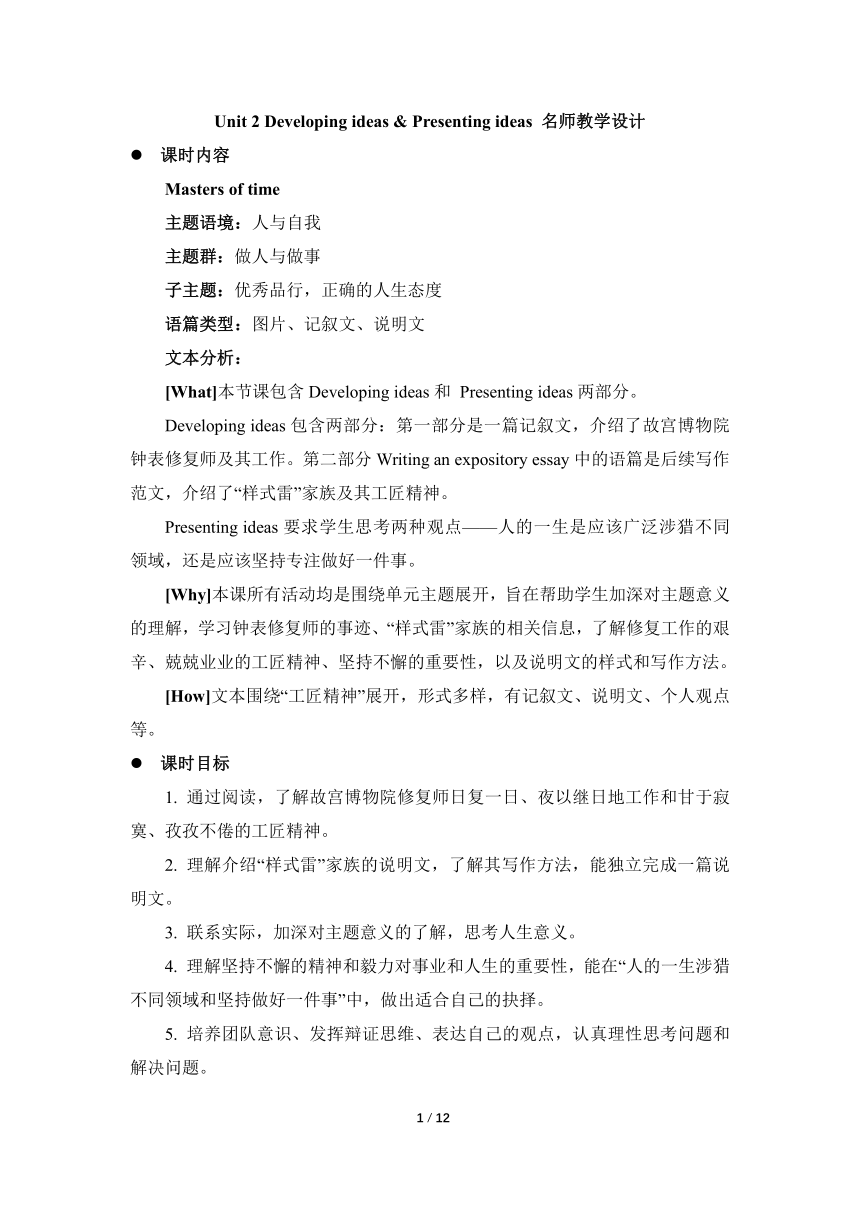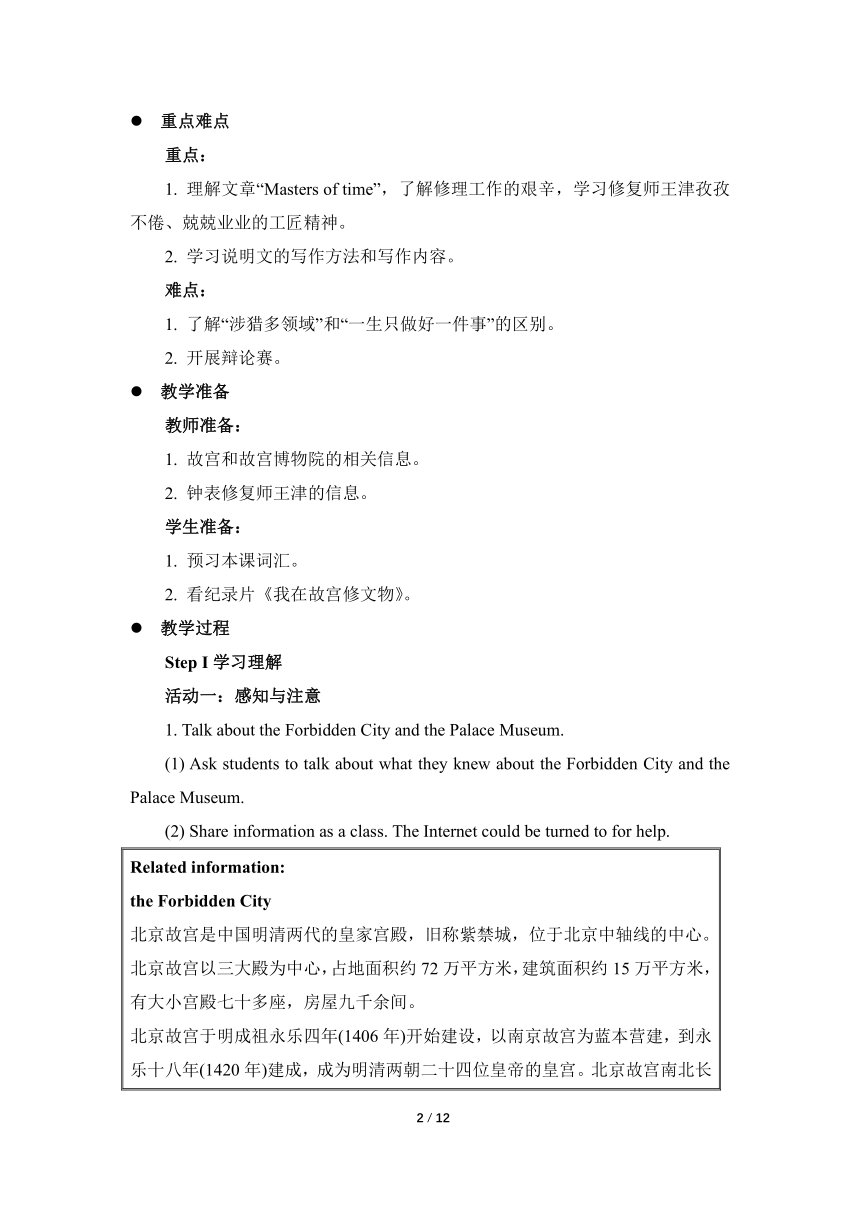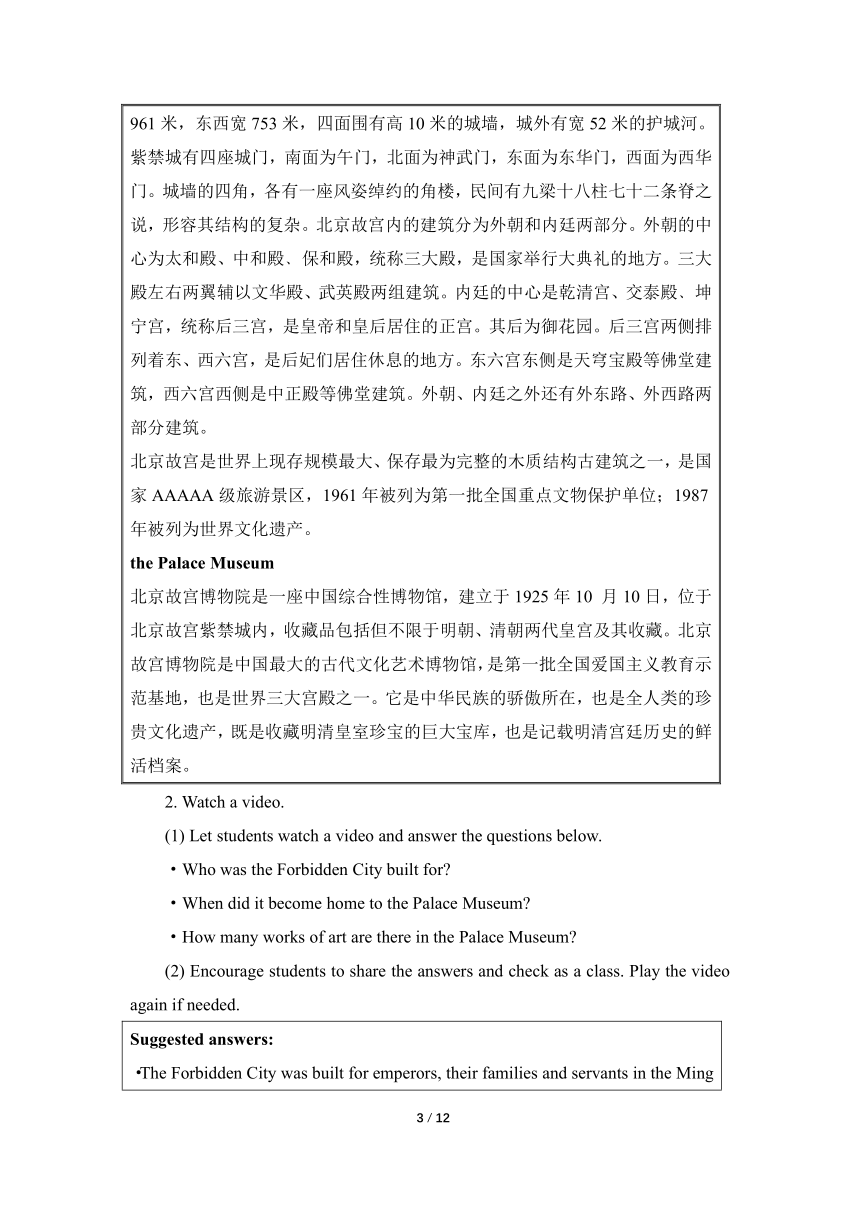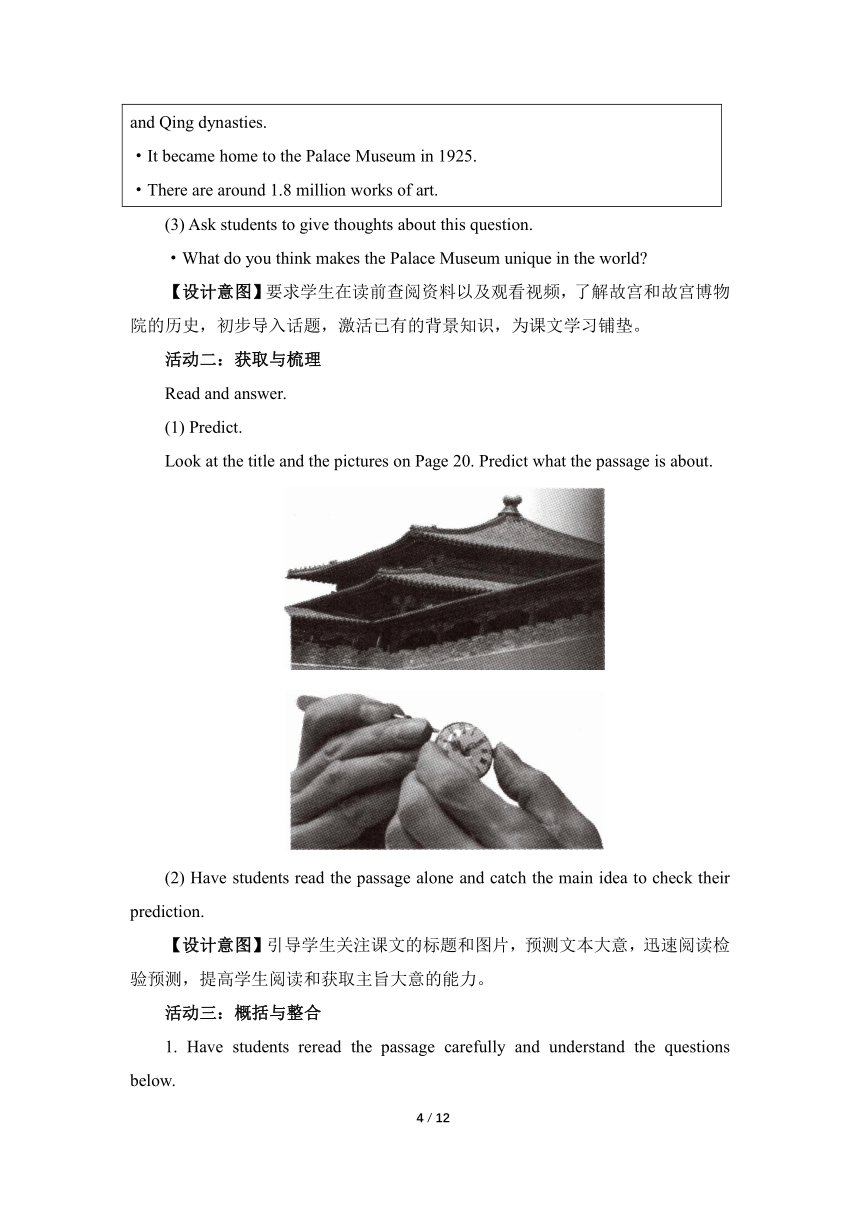外研版(2019)选择性必修第三册Unit 2 A life’s work Developing ideas and Presenting ideas 名师教学设计
文档属性
| 名称 | 外研版(2019)选择性必修第三册Unit 2 A life’s work Developing ideas and Presenting ideas 名师教学设计 |  | |
| 格式 | docx | ||
| 文件大小 | 549.3KB | ||
| 资源类型 | 教案 | ||
| 版本资源 | 外研版(2019) | ||
| 科目 | 英语 | ||
| 更新时间 | 2023-03-05 13:51:35 | ||
图片预览





文档简介
Unit 2 Developing ideas & Presenting ideas 名师教学设计
课时内容
Masters of time
主题语境:人与自我
主题群:做人与做事
子主题:优秀品行,正确的人生态度
语篇类型:图片、记叙文、说明文
文本分析:
[What]本节课包含Developing ideas和 Presenting ideas两部分。
Developing ideas包含两部分:第一部分是一篇记叙文,介绍了故宫博物院钟表修复师及其工作。第二部分Writing an expository essay中的语篇是后续写作范文,介绍了“样式雷”家族及其工匠精神。
Presenting ideas要求学生思考两种观点——人的一生是应该广泛涉猎不同领域,还是应该坚持专注做好一件事。
[Why]本课所有活动均是围绕单元主题展开,旨在帮助学生加深对主题意义的理解,学习钟表修复师的事迹、“样式雷”家族的相关信息,了解修复工作的艰辛、兢兢业业的工匠精神、坚持不懈的重要性,以及说明文的样式和写作方法。
[How]文本围绕“工匠精神”展开,形式多样,有记叙文、说明文、个人观点等。
课时目标
1. 通过阅读,了解故宫博物院修复师日复一日、夜以继日地工作和甘于寂寞、孜孜不倦的工匠精神。
2. 理解介绍“样式雷”家族的说明文,了解其写作方法,能独立完成一篇说明文。
3. 联系实际,加深对主题意义的了解,思考人生意义。
4. 理解坚持不懈的精神和毅力对事业和人生的重要性,能在“人的一生涉猎不同领域和坚持做好一件事”中,做出适合自己的抉择。
5. 培养团队意识、发挥辩证思维、表达自己的观点,认真理性思考问题和解决问题。
重点难点
重点:
1. 理解文章“Masters of time”,了解修理工作的艰辛,学习修复师王津孜孜不倦、兢兢业业的工匠精神。
2. 学习说明文的写作方法和写作内容。
难点:
1. 了解“涉猎多领域”和“一生只做好一件事”的区别。
2. 开展辩论赛。
教学准备
教师准备:
1. 故宫和故宫博物院的相关信息。
2. 钟表修复师王津的信息。
学生准备:
1. 预习本课词汇。
2. 看纪录片《我在故宫修文物》。
教学过程
Step I学习理解
活动一:感知与注意
1. Talk about the Forbidden City and the Palace Museum.
(1) Ask students to talk about what they knew about the Forbidden City and the Palace Museum.
(2) Share information as a class. The Internet could be turned to for help.
Related information: the Forbidden City 北京故宫是中国明清两代的皇家宫殿,旧称紫禁城,位于北京中轴线的中心。北京故宫以三大殿为中心,占地面积约72万平方米,建筑面积约15万平方米,有大小宫殿七十多座,房屋九千余间。 北京故宫于明成祖永乐四年(1406年)开始建设,以南京故宫为蓝本营建,到永乐十八年(1420年)建成,成为明清两朝二十四位皇帝的皇宫。北京故宫南北长961米,东西宽753米,四面围有高10米的城墙,城外有宽52米的护城河。紫禁城有四座城门,南面为午门,北面为神武门,东面为东华门,西面为西华门。城墙的四角,各有一座风姿绰约的角楼,民间有九梁十八柱七十二条脊之说,形容其结构的复杂。北京故宫内的建筑分为外朝和内廷两部分。外朝的中心为太和殿、中和殿﹑保和殿,统称三大殿,是国家举行大典礼的地方。三大殿左右两翼辅以文华殿、武英殿两组建筑。内廷的中心是乾清宫、交泰殿﹑坤宁宫,统称后三宫,是皇帝和皇后居住的正宫。其后为御花园。后三宫两侧排列着东、西六宫,是后妃们居住休息的地方。东六宫东侧是天穹宝殿等佛堂建筑,西六宫西侧是中正殿等佛堂建筑。外朝、内廷之外还有外东路、外西路两部分建筑。 北京故宫是世界上现存规模最大、保存最为完整的木质结构古建筑之一,是国家AAAAA级旅游景区,1961年被列为第一批全国重点文物保护单位;1987年被列为世界文化遗产。 the Palace Museum 北京故宫博物院是一座中国综合性博物馆,建立于1925年10 月10日,位于北京故宫紫禁城内,收藏品包括但不限于明朝、清朝两代皇宫及其收藏。北京故宫博物院是中国最大的古代文化艺术博物馆,是第一批全国爱国主义教育示范基地,也是世界三大宫殿之一。它是中华民族的骄傲所在,也是全人类的珍贵文化遗产,既是收藏明清皇室珍宝的巨大宝库,也是记载明清宫廷历史的鲜活档案。
2. Watch a video.
(1) Let students watch a video and answer the questions below.
·Who was the Forbidden City built for
·When did it become home to the Palace Museum
·How many works of art are there in the Palace Museum
(2) Encourage students to share the answers and check as a class. Play the video again if needed.
Suggested answers: ·The Forbidden City was built for emperors, their families and servants in the Ming and Qing dynasties. ·It became home to the Palace Museum in 1925. ·There are around 1.8 million works of art.
(3) Ask students to give thoughts about this question.
·What do you think makes the Palace Museum unique in the world
【设计意图】要求学生在读前查阅资料以及观看视频,了解故宫和故宫博物院的历史,初步导入话题,激活已有的背景知识,为课文学习铺垫。
活动二:获取与梳理
Read and answer.
(1) Predict.
Look at the title and the pictures on Page 20. Predict what the passage is about.
(2) Have students read the passage alone and catch the main idea to check their prediction.
【设计意图】引导学生关注课文的标题和图片,预测文本大意,迅速阅读检验预测,提高学生阅读和获取主旨大意的能力。
活动三:概括与整合
1. Have students reread the passage carefully and understand the questions below.
a Why is Wang Jin optimistic about the future of the timepieces in the Palace Museum b Why is it painstaking for Wang Jin and his students to repair the collection of timepieces in the Palace Museum c What has been done to the clocks that date back to the time of Emperor Qianlong d Who is Wang Jin and where does he work e What qualities do Wang Jin and his colleagues display in their work f What was special about Wang Jin and his student Qi Haonan
2. Ask students to match the questions to the paragraphs.
3. Tell students to work in pairs to find out the answers to these questions. Then have them share ingroups or in class.
Suggested answers: a (Para. 5) Because he has passed on his skills to a new generation of artisans, who will not only help preserve traditional skills but also bring innovation to the art of clock repairing so that it stands the test of time. b (Para. 3) Because repairing such a large and important collection of timepieces involves complex work, unique methods of restoration and sourcing difficult-to-find materials, which take a lot of time, care and attention to detail. c (Para. 4) Wang Jin has spent eight months adjusting the gigantic clock, which is about to be wound up and brought back to life. d (Para. 1) He is a clock restoration master, working in Xi San Suo in the Forbidden City. e (Para. 6) They display qualities of skill, patience, modesty and devotion in their work. f (Para. 2) They used to be the only two timepiece restorers in the Palace Museum
【设计意图】通过将问题与课文段落进行匹配并回答,使学生能够进一步加深对课文主题、细节和结构的了解,加深对主题意义的探究。
Step II应用实践
活动四:描述与阐释
Retell the passage.
(1) Ask students to reread the passage and draw mind maps or take notes.
(2) Tell students to write a summary.
(3) Have students retell the passage according to the summary in groups of four.
(4) Invite volunteers to represent in class.
【设计意图】在学习理解类活动的基础上,引导学生围绕主题画思维图或记笔记、写摘要、复述文本,逐渐实现对语言知识和文化知识的内化,促进语言运用的自动化,助力学生将知识转化为能力。
活动五:分析与判断
Think and share.
Lead students to think about the following questions and share their ideas.
·What is your understanding of the title, “Masters of time” What figure of speech does the author use
·What is your understanding of the sentence, “This is a race against time that can never be won” Do you agree with this Give your reasons.
·What do Bill Cunningham and Wang Jin in the two reading passages in this unit have in common
·What can you do to help to pass on traditional skills and the spirit of craftsmanship
Suggested answers: ·(略) ·(略) ·They are both devoted, motivated, passionate and skilled masters in their fields of work. ·(略)
活动六:内化与运用
1. Request students to work in groups and give a speech about the spirit of craftsmanship in the Palace Museum.
(1) Think about other masters in the Palace Museum. Then discuss the questions within your group to prepare for your speech. Do further research if necessary.
·Who are the masters
·What fields do they work in
·What specific examples can you give of their work
·What aspects of the spirit of craftsmanship are demonstrated through their work
·How can you develop and display such spirit in daily life
(2) Organise your speech by completing the table.
Aspects of the spirit of craftsmanship
Supporting examples
Conclusion
(3) Give your speech to the class.
2. Tell students to think about their performance in the speech. Have them vote for the most convincing speech and ask the speaker to share some public speaking skills.
【设计意图】在学习理解的基础上,联系实际,帮助学生深入理解课文,并通过网络和图书馆等渠道,发表演讲,介绍故宫博物院其他修复师们的工作和学习他们的工匠精神,进行知识和思维能力的拓展与迁移,培养学生的高阶思维能力。
Step III 迁移创新
活动七:Writing
1. Direct students to read the passage on Page 23 and answer the questions.
·What is the passage about
·What qualities of the Lei family are mentioned Find examples in the passage to support your answers.
·What is the conclusion of the passage
Suggested answers: ·The passage is about the Lei family, who for seven generations were behind the marvels of imperial architecture. ·The qualities mentioned are those of skill, innovation, diligence and humility. This is evident in their buildings surviving for hundreds of: years, in their use of a pioneering grid system to plan their projects, in each generation’s conscientious learning of their craft and undertaking ambitious projects, and in their works being more associated with the imperial court than with them. ·Although the names of those who created these remarkable works may not be known by future generations, their spirit of craftsmanship is everlasting.
2. Request students to choose one person who demonstrates the spirit of craftsmanship and complete the notes. Do further research if necessary.
Person: ____________________________________________________________ Qualities: __________________________________________________________ Examples: _________________________________________________________ Conclusion: ________________________________________________________
3. Ask students to read “Learning to learn”.
Learning to learn
An expository essay contains a fair and balanced analysis of an event, a situation or an idea. It commonly begins by clearly stating what it aims to explain or analyse. The main body comprises paragraphs with supporting evidence and facts. It concludes by reviewing the main theme of the essay in light of all the evidence that has been presented.
4. Encourage students to write an expository essay.
5. Request student to work in pairs, make improvements to each other’s essays and share them with the class and consider how well they have understood how to write expository essays.
Example: The vividly coloured, finely shaped figurines of “Clay Figure Zhang” have been seeing a surge in popularity as an authentic and valuable traditional craft. The nearly 200-year history of “Clay Figure Zhang" began with Zhang Mingshan, who became known for his ability to breathe life and beauty into these painted clay figurines. Born into a poor family, Zhang Mingshan made them as a means of earning a living. He often visited markets where he observed people of all walks of life, and went to theatres to observe those performing on stage. Day in, day out, he used tonnes of clay to mould what he saw, and sometimes added decorative items or new features to the figurines. So vivid and lifelike were they that they attracted crowds of spectators to the stand from which he sold them. Fortunately, Zhang Mingshan’s craftsmanship has been passed down through his descendents, with these distinctive clay figurines now being crafted by the sixth generation of “Clay Figure Zhang”.
【设计意图】引导学生学习和了解说明文的文体结构和内容特点,指导学生选择自己心中具有“工匠精神”的人,并仿照范文完成初稿和终稿,进行知识和思维能力的拓展与迁移。
活动八:Presenting ideas
1. Have students work in groups and read the two points of view. Then ask them to discuss the questions.
James Ivy
I can’t understand why some people spend their whole life doing just one thing. I know these activities require time and effort to do, but I’d rather try as many different things as possible. I don’t want to regret things when Fm old! I admire those people who devote their whole lives to one thing. Not only have they mastered their skills, but they have also mastered their lives! I hope that I can dedicate myself to, and one day master, a craft.
·What is James trying to express
·What is Ivy trying to express
·Which person do you agree with
2. Encourage students to work in groups and take sides. Let them think of arguments to support their points of view and make notes.
Point of view: ______________________________________________________ Arguments: ________________________________________________________ Supporting examples: ________________________________________________
3. Tell students to prepare for a debate and consider the following:
·the roles and responsibilities for each member of your group
·your arguments, opening and summary
·the opposing arguments you might face and how you can respond to them
·useful words, expressions and structures
4. Let students team up with a group with the opposite point of view and hold a debate.
【设计意图】要求学生阅读两种观点,分组讨论自己的理解,指导学生开展辩论,提出论点,寻找论据,运用所学词汇和表达,关注语言表达和培养逻辑思维,促进能力向素养的转化。
活动九:Reflection
Ask students to write a reflection after completing this unit and consider the following:
·What is your understanding of the spirit of craftsmanship
·What text types have you learnt about What are their features
·What words,expressions and structures have you learnt
·What improvement have you made in understanding different cultures
·What improvement have you made in using learning strategies and exploring effective ways of learning
·What improvement have you made in analysing and solving problems
【设计意图】要求学生从文本、语言、文化、学习方法、解决问题的能力等方面进行自我评价和总结,检测自己对本单元的理解程度,并通过小组讨论寻找改进方法和完善学习策略。
活动十:Critical thinking
了解杭州“工匠日”的创立及意义。
Related information: 自2019年起,杭州将每年的9月26日设为“工匠日”,成为全国第一个为工匠设立专属节日的城市。设立“工匠日”是为了激励工匠们创新创造,也是为了增厚工匠精神的土壤。无论是开展“杭州工匠”评选与表彰、打造劳模工匠文化公园与工匠元素特色街区,还是创立“杭工云课”等线上线下教学平台、建立健全“工匠带徒”制度,众多举措让工匠有荣誉感、成就感,让崇尚工匠精神成为一种新时尚。
【设计意图】通过了解“工匠日”,理解时代发展需要大国工匠,全社会都要大力弘扬工匠精神,让崇尚工匠精神的理念深入人心,让每一位劳动者在新时代书写出更多、更精彩、更动人的“工匠故事”。
板书设计
Unit 2 A life’s work Period IV Developing ideas & Presenting ideas I. 学习理解 活动一:感知与注意 1. Talk about the Forbidden City and the Palace Museum. 2. Watch a video. 活动二:获取与梳理 Read and answer. 活动三:概括与整合 1. Reread and understand. 2. Match the questions to the paragraphs. 3. Find out the answers to the questions. Ⅱ. 应用实践 活动四:描述与阐释 Retell the passage. 活动五:分析与判断 Think and share. 活动六:内化与运用 Give a speech. Ⅲ. 迁移创新 活动七:Writing 活动八:Presenting ideas 活动九:Reflection 活动十:Critical thinking
2 / 2
课时内容
Masters of time
主题语境:人与自我
主题群:做人与做事
子主题:优秀品行,正确的人生态度
语篇类型:图片、记叙文、说明文
文本分析:
[What]本节课包含Developing ideas和 Presenting ideas两部分。
Developing ideas包含两部分:第一部分是一篇记叙文,介绍了故宫博物院钟表修复师及其工作。第二部分Writing an expository essay中的语篇是后续写作范文,介绍了“样式雷”家族及其工匠精神。
Presenting ideas要求学生思考两种观点——人的一生是应该广泛涉猎不同领域,还是应该坚持专注做好一件事。
[Why]本课所有活动均是围绕单元主题展开,旨在帮助学生加深对主题意义的理解,学习钟表修复师的事迹、“样式雷”家族的相关信息,了解修复工作的艰辛、兢兢业业的工匠精神、坚持不懈的重要性,以及说明文的样式和写作方法。
[How]文本围绕“工匠精神”展开,形式多样,有记叙文、说明文、个人观点等。
课时目标
1. 通过阅读,了解故宫博物院修复师日复一日、夜以继日地工作和甘于寂寞、孜孜不倦的工匠精神。
2. 理解介绍“样式雷”家族的说明文,了解其写作方法,能独立完成一篇说明文。
3. 联系实际,加深对主题意义的了解,思考人生意义。
4. 理解坚持不懈的精神和毅力对事业和人生的重要性,能在“人的一生涉猎不同领域和坚持做好一件事”中,做出适合自己的抉择。
5. 培养团队意识、发挥辩证思维、表达自己的观点,认真理性思考问题和解决问题。
重点难点
重点:
1. 理解文章“Masters of time”,了解修理工作的艰辛,学习修复师王津孜孜不倦、兢兢业业的工匠精神。
2. 学习说明文的写作方法和写作内容。
难点:
1. 了解“涉猎多领域”和“一生只做好一件事”的区别。
2. 开展辩论赛。
教学准备
教师准备:
1. 故宫和故宫博物院的相关信息。
2. 钟表修复师王津的信息。
学生准备:
1. 预习本课词汇。
2. 看纪录片《我在故宫修文物》。
教学过程
Step I学习理解
活动一:感知与注意
1. Talk about the Forbidden City and the Palace Museum.
(1) Ask students to talk about what they knew about the Forbidden City and the Palace Museum.
(2) Share information as a class. The Internet could be turned to for help.
Related information: the Forbidden City 北京故宫是中国明清两代的皇家宫殿,旧称紫禁城,位于北京中轴线的中心。北京故宫以三大殿为中心,占地面积约72万平方米,建筑面积约15万平方米,有大小宫殿七十多座,房屋九千余间。 北京故宫于明成祖永乐四年(1406年)开始建设,以南京故宫为蓝本营建,到永乐十八年(1420年)建成,成为明清两朝二十四位皇帝的皇宫。北京故宫南北长961米,东西宽753米,四面围有高10米的城墙,城外有宽52米的护城河。紫禁城有四座城门,南面为午门,北面为神武门,东面为东华门,西面为西华门。城墙的四角,各有一座风姿绰约的角楼,民间有九梁十八柱七十二条脊之说,形容其结构的复杂。北京故宫内的建筑分为外朝和内廷两部分。外朝的中心为太和殿、中和殿﹑保和殿,统称三大殿,是国家举行大典礼的地方。三大殿左右两翼辅以文华殿、武英殿两组建筑。内廷的中心是乾清宫、交泰殿﹑坤宁宫,统称后三宫,是皇帝和皇后居住的正宫。其后为御花园。后三宫两侧排列着东、西六宫,是后妃们居住休息的地方。东六宫东侧是天穹宝殿等佛堂建筑,西六宫西侧是中正殿等佛堂建筑。外朝、内廷之外还有外东路、外西路两部分建筑。 北京故宫是世界上现存规模最大、保存最为完整的木质结构古建筑之一,是国家AAAAA级旅游景区,1961年被列为第一批全国重点文物保护单位;1987年被列为世界文化遗产。 the Palace Museum 北京故宫博物院是一座中国综合性博物馆,建立于1925年10 月10日,位于北京故宫紫禁城内,收藏品包括但不限于明朝、清朝两代皇宫及其收藏。北京故宫博物院是中国最大的古代文化艺术博物馆,是第一批全国爱国主义教育示范基地,也是世界三大宫殿之一。它是中华民族的骄傲所在,也是全人类的珍贵文化遗产,既是收藏明清皇室珍宝的巨大宝库,也是记载明清宫廷历史的鲜活档案。
2. Watch a video.
(1) Let students watch a video and answer the questions below.
·Who was the Forbidden City built for
·When did it become home to the Palace Museum
·How many works of art are there in the Palace Museum
(2) Encourage students to share the answers and check as a class. Play the video again if needed.
Suggested answers: ·The Forbidden City was built for emperors, their families and servants in the Ming and Qing dynasties. ·It became home to the Palace Museum in 1925. ·There are around 1.8 million works of art.
(3) Ask students to give thoughts about this question.
·What do you think makes the Palace Museum unique in the world
【设计意图】要求学生在读前查阅资料以及观看视频,了解故宫和故宫博物院的历史,初步导入话题,激活已有的背景知识,为课文学习铺垫。
活动二:获取与梳理
Read and answer.
(1) Predict.
Look at the title and the pictures on Page 20. Predict what the passage is about.
(2) Have students read the passage alone and catch the main idea to check their prediction.
【设计意图】引导学生关注课文的标题和图片,预测文本大意,迅速阅读检验预测,提高学生阅读和获取主旨大意的能力。
活动三:概括与整合
1. Have students reread the passage carefully and understand the questions below.
a Why is Wang Jin optimistic about the future of the timepieces in the Palace Museum b Why is it painstaking for Wang Jin and his students to repair the collection of timepieces in the Palace Museum c What has been done to the clocks that date back to the time of Emperor Qianlong d Who is Wang Jin and where does he work e What qualities do Wang Jin and his colleagues display in their work f What was special about Wang Jin and his student Qi Haonan
2. Ask students to match the questions to the paragraphs.
3. Tell students to work in pairs to find out the answers to these questions. Then have them share ingroups or in class.
Suggested answers: a (Para. 5) Because he has passed on his skills to a new generation of artisans, who will not only help preserve traditional skills but also bring innovation to the art of clock repairing so that it stands the test of time. b (Para. 3) Because repairing such a large and important collection of timepieces involves complex work, unique methods of restoration and sourcing difficult-to-find materials, which take a lot of time, care and attention to detail. c (Para. 4) Wang Jin has spent eight months adjusting the gigantic clock, which is about to be wound up and brought back to life. d (Para. 1) He is a clock restoration master, working in Xi San Suo in the Forbidden City. e (Para. 6) They display qualities of skill, patience, modesty and devotion in their work. f (Para. 2) They used to be the only two timepiece restorers in the Palace Museum
【设计意图】通过将问题与课文段落进行匹配并回答,使学生能够进一步加深对课文主题、细节和结构的了解,加深对主题意义的探究。
Step II应用实践
活动四:描述与阐释
Retell the passage.
(1) Ask students to reread the passage and draw mind maps or take notes.
(2) Tell students to write a summary.
(3) Have students retell the passage according to the summary in groups of four.
(4) Invite volunteers to represent in class.
【设计意图】在学习理解类活动的基础上,引导学生围绕主题画思维图或记笔记、写摘要、复述文本,逐渐实现对语言知识和文化知识的内化,促进语言运用的自动化,助力学生将知识转化为能力。
活动五:分析与判断
Think and share.
Lead students to think about the following questions and share their ideas.
·What is your understanding of the title, “Masters of time” What figure of speech does the author use
·What is your understanding of the sentence, “This is a race against time that can never be won” Do you agree with this Give your reasons.
·What do Bill Cunningham and Wang Jin in the two reading passages in this unit have in common
·What can you do to help to pass on traditional skills and the spirit of craftsmanship
Suggested answers: ·(略) ·(略) ·They are both devoted, motivated, passionate and skilled masters in their fields of work. ·(略)
活动六:内化与运用
1. Request students to work in groups and give a speech about the spirit of craftsmanship in the Palace Museum.
(1) Think about other masters in the Palace Museum. Then discuss the questions within your group to prepare for your speech. Do further research if necessary.
·Who are the masters
·What fields do they work in
·What specific examples can you give of their work
·What aspects of the spirit of craftsmanship are demonstrated through their work
·How can you develop and display such spirit in daily life
(2) Organise your speech by completing the table.
Aspects of the spirit of craftsmanship
Supporting examples
Conclusion
(3) Give your speech to the class.
2. Tell students to think about their performance in the speech. Have them vote for the most convincing speech and ask the speaker to share some public speaking skills.
【设计意图】在学习理解的基础上,联系实际,帮助学生深入理解课文,并通过网络和图书馆等渠道,发表演讲,介绍故宫博物院其他修复师们的工作和学习他们的工匠精神,进行知识和思维能力的拓展与迁移,培养学生的高阶思维能力。
Step III 迁移创新
活动七:Writing
1. Direct students to read the passage on Page 23 and answer the questions.
·What is the passage about
·What qualities of the Lei family are mentioned Find examples in the passage to support your answers.
·What is the conclusion of the passage
Suggested answers: ·The passage is about the Lei family, who for seven generations were behind the marvels of imperial architecture. ·The qualities mentioned are those of skill, innovation, diligence and humility. This is evident in their buildings surviving for hundreds of: years, in their use of a pioneering grid system to plan their projects, in each generation’s conscientious learning of their craft and undertaking ambitious projects, and in their works being more associated with the imperial court than with them. ·Although the names of those who created these remarkable works may not be known by future generations, their spirit of craftsmanship is everlasting.
2. Request students to choose one person who demonstrates the spirit of craftsmanship and complete the notes. Do further research if necessary.
Person: ____________________________________________________________ Qualities: __________________________________________________________ Examples: _________________________________________________________ Conclusion: ________________________________________________________
3. Ask students to read “Learning to learn”.
Learning to learn
An expository essay contains a fair and balanced analysis of an event, a situation or an idea. It commonly begins by clearly stating what it aims to explain or analyse. The main body comprises paragraphs with supporting evidence and facts. It concludes by reviewing the main theme of the essay in light of all the evidence that has been presented.
4. Encourage students to write an expository essay.
5. Request student to work in pairs, make improvements to each other’s essays and share them with the class and consider how well they have understood how to write expository essays.
Example: The vividly coloured, finely shaped figurines of “Clay Figure Zhang” have been seeing a surge in popularity as an authentic and valuable traditional craft. The nearly 200-year history of “Clay Figure Zhang" began with Zhang Mingshan, who became known for his ability to breathe life and beauty into these painted clay figurines. Born into a poor family, Zhang Mingshan made them as a means of earning a living. He often visited markets where he observed people of all walks of life, and went to theatres to observe those performing on stage. Day in, day out, he used tonnes of clay to mould what he saw, and sometimes added decorative items or new features to the figurines. So vivid and lifelike were they that they attracted crowds of spectators to the stand from which he sold them. Fortunately, Zhang Mingshan’s craftsmanship has been passed down through his descendents, with these distinctive clay figurines now being crafted by the sixth generation of “Clay Figure Zhang”.
【设计意图】引导学生学习和了解说明文的文体结构和内容特点,指导学生选择自己心中具有“工匠精神”的人,并仿照范文完成初稿和终稿,进行知识和思维能力的拓展与迁移。
活动八:Presenting ideas
1. Have students work in groups and read the two points of view. Then ask them to discuss the questions.
James Ivy
I can’t understand why some people spend their whole life doing just one thing. I know these activities require time and effort to do, but I’d rather try as many different things as possible. I don’t want to regret things when Fm old! I admire those people who devote their whole lives to one thing. Not only have they mastered their skills, but they have also mastered their lives! I hope that I can dedicate myself to, and one day master, a craft.
·What is James trying to express
·What is Ivy trying to express
·Which person do you agree with
2. Encourage students to work in groups and take sides. Let them think of arguments to support their points of view and make notes.
Point of view: ______________________________________________________ Arguments: ________________________________________________________ Supporting examples: ________________________________________________
3. Tell students to prepare for a debate and consider the following:
·the roles and responsibilities for each member of your group
·your arguments, opening and summary
·the opposing arguments you might face and how you can respond to them
·useful words, expressions and structures
4. Let students team up with a group with the opposite point of view and hold a debate.
【设计意图】要求学生阅读两种观点,分组讨论自己的理解,指导学生开展辩论,提出论点,寻找论据,运用所学词汇和表达,关注语言表达和培养逻辑思维,促进能力向素养的转化。
活动九:Reflection
Ask students to write a reflection after completing this unit and consider the following:
·What is your understanding of the spirit of craftsmanship
·What text types have you learnt about What are their features
·What words,expressions and structures have you learnt
·What improvement have you made in understanding different cultures
·What improvement have you made in using learning strategies and exploring effective ways of learning
·What improvement have you made in analysing and solving problems
【设计意图】要求学生从文本、语言、文化、学习方法、解决问题的能力等方面进行自我评价和总结,检测自己对本单元的理解程度,并通过小组讨论寻找改进方法和完善学习策略。
活动十:Critical thinking
了解杭州“工匠日”的创立及意义。
Related information: 自2019年起,杭州将每年的9月26日设为“工匠日”,成为全国第一个为工匠设立专属节日的城市。设立“工匠日”是为了激励工匠们创新创造,也是为了增厚工匠精神的土壤。无论是开展“杭州工匠”评选与表彰、打造劳模工匠文化公园与工匠元素特色街区,还是创立“杭工云课”等线上线下教学平台、建立健全“工匠带徒”制度,众多举措让工匠有荣誉感、成就感,让崇尚工匠精神成为一种新时尚。
【设计意图】通过了解“工匠日”,理解时代发展需要大国工匠,全社会都要大力弘扬工匠精神,让崇尚工匠精神的理念深入人心,让每一位劳动者在新时代书写出更多、更精彩、更动人的“工匠故事”。
板书设计
Unit 2 A life’s work Period IV Developing ideas & Presenting ideas I. 学习理解 活动一:感知与注意 1. Talk about the Forbidden City and the Palace Museum. 2. Watch a video. 活动二:获取与梳理 Read and answer. 活动三:概括与整合 1. Reread and understand. 2. Match the questions to the paragraphs. 3. Find out the answers to the questions. Ⅱ. 应用实践 活动四:描述与阐释 Retell the passage. 活动五:分析与判断 Think and share. 活动六:内化与运用 Give a speech. Ⅲ. 迁移创新 活动七:Writing 活动八:Presenting ideas 活动九:Reflection 活动十:Critical thinking
2 / 2
